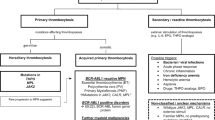Abstract
Platelet satellitism (PS) is defined as adherence of platelets on the surface of polymorphonuclear leucocytes and imparting a rosette-like appearance especially in ethylenediaminetetraacetic acid (EDTA) whole blood samples. We here present a case of spurious thrombocytopenia resulting from florid platelet adherence on the surface of neutrophils.
Similar content being viewed by others
Platelet satellitism (PS) is an uncommon and unique phenomenon observed on peripheral blood smears. It is defined as adherence of platelets on the surface of polymorphonuclear leucocytes and imparting a rosette-like appearance. This might result in spurious or pseudo-thrombocytopenia on complete blood count (CBC) performed on a hematology analyzers.
We here present a case of a 65-year-old female who underwent CBC as part of her work up for surgery for right renal calculi. She presented with history of pain in right flank on and off for 2 years. She was afebrile and her urine culture was sterile. The CBC done using ethylenediaminetetraacetic acid (EDTA) whole blood sample on hematology analyzer (LH780, Beckman Coulter) revealed a platelet count of 70 × 109/L. The other CBC parameters were within normal limits. The reflex peripheral smear prepared and stained with Leishman stain revealed florid platelet adherence on the surface of polymorphonuclear leucocytes. The platelet adhesion was not seen on the surface of monocytes (Fig. 1).
The platelet count was repeated using heparin anti-coagulated whole blood sample and normal platelet counts were obtained (168 × 109/L) and no platelet adhesion was noted on peripheral smear.
The PS was first described in 1963 by Field and Macleod and since then, many cases have been reported in the literature [2]. The PS is a predominantly in vitro phenomenon and seen in EDTA anti-coagulated samples. However, it has also been rarely reported in heparin and sodium citrate samples.
The mechanism for PS is not completely understood; however, it has been shown that PS is an in vitro phenomenon caused by EDTA-dependent IgG auto-antibodies (antiplatelet and antineutrophil) present in the patient sera. The primary target antigens reported are glycoprotein IIb/IIIa complex of the platelet membrane and the neutrophil Fcγ receptor III (FcγRIII) [1]. These auto-antibodies are naturally present in some individuals and no clear correlation between presence of antibodies and specific clinical condition or use of drugs has been reported in the literature.
The occurrence of this rare phenomenon may result in spurious thrombocytopenia which might result in the unnecessary delay in surgical procedures or unnecessary further tests to investigate thrombocytopenia or rare platelet transfusion in emergency settings.
The careful peripheral smear examination to pick PS and repeat CBC with heparin or citrate anti-coagulated samples will help in obtaining correct platelet counts.
References
Chakrabarti I (2014) Platelet satellitism: a rare, interesting, in vitro phenomenon. Indian J Hematol Blood Transfus. 30(3):213–214
Bizzaro N, Goldschmeding R, Von Dem Borne AEGK Platelet satellitism is Fc γ RIII (CD 16) receptor–mediated. American Journal of Clinical Pathology 103(6):740–744
Author information
Authors and Affiliations
Corresponding author
Additional information
Publisher’s note
Springer Nature remains neutral with regard to jurisdictional claims in published maps and institutional affiliations.
Rights and permissions
About this article
Cite this article
Bhar, V.S., Singh, R. Platelet satellitism: unusual cause of spurious thrombocytopenia. J Hematopathol 12, 171–172 (2019). https://doi.org/10.1007/s12308-019-00365-9
Received:
Accepted:
Published:
Issue Date:
DOI: https://doi.org/10.1007/s12308-019-00365-9





